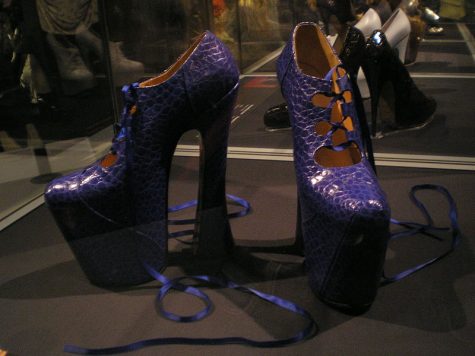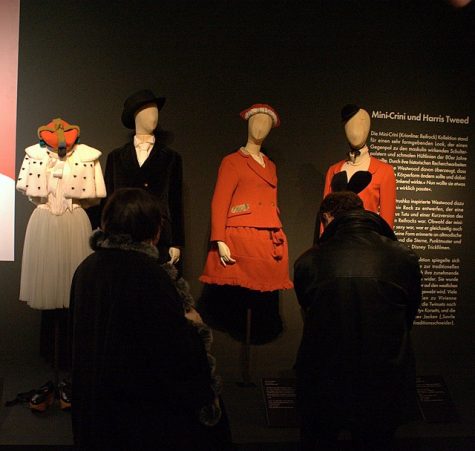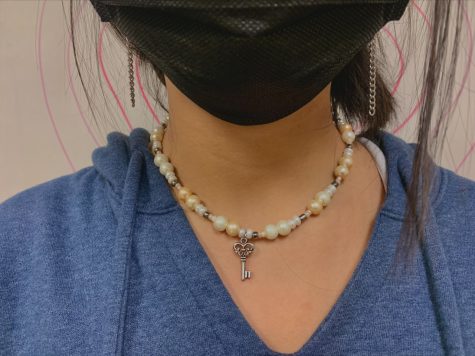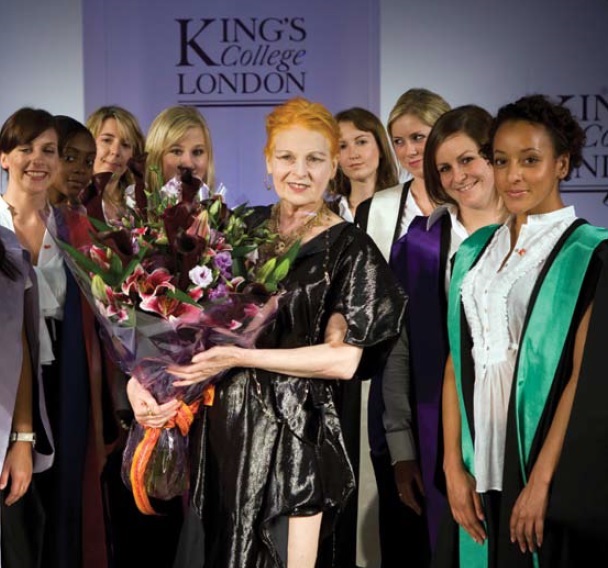A designer’s backstory: Vivienne Westwood
Vivienne’s rise to fame and brief commentary about her influence in this generation’s fashion sense.
FormerBBC, CC BY-SA 4.0
Vivienne holding a bouquet of flowers after the unveiling of the new academic gowns of King’s College, which she designed.

When hearing the name “Vivienne Westwood”, many things may come to mind, such as Naomi Campbell’s fall in 1993, punk designs that dressed a movement, and an iconic pearl choker. The dresses, the shoes, and the infinite shots of models strutting down the runway are the things that make people look twice upon coming across those pictures or items. But Vivienne’s designs are more than just an image to save in your Pinterest board. Her life story and the inspiration behind the products she sells are worth telling. This is a designer’s backstory.
Vivienne Westwood was born on April 8, 1941, as Vivienne Isabel Swire. She was born in Tintwistle, Derbyshire, a small town in England. She came from very humble beginnings and was far from the English elite. Vivienne was very independent as she grew up and she was making her own clothes by the time she was 16 years old. Her parents moved to Harrow, a large town in greater London, when she was 17. She enrolled in a teacher-training college and worked at a factory, and she eventually became a certified primary school teacher.
She married Derek Westwood and had a baby, named Ben, with him the same year. By 1963, her life seemed settled: a job, married, and a kid. What else could a woman aspire to?
But Vivienne was not content. She needed to know more of the world.
She divorced Derek and continued to work as a school teacher, while also selling handmade jewelry as a side-hustle. However, everything changed for Vivienne in 1965 after being introduced to Malcom McLaren by her brother. He was a visual artist, clothes designer, artist manager, and musician, to name a few. Westwood was captivated by his designs, and by him. After succumbing to his advances, they had a child together, but McLaren’s disinterest in being a father drove a wedge between them, and they split in 1968, though they remained in contact.
Despite all of this, McLaren was instrumental in her growth as a fashion designer. Many people credit him with exposing her to unique fashion and giving her the confidence to stray away from traditional clothes. He was also one of the reasons why Vivienne’s designs gained popularity, as he was the manager of the “Sex Pistols” and the band would often dress in her clothes since she was their stylist.
During the late 60’s, hippie fashion was still in style in London, but our ex-lovebirds were not inspired by this, they were more drawn to rebellion and 1950’s inspired clothes, she often liked to bring back trends from the past into her designs. Vivienne started making Teddy Boy clothes for McLaren and they opened a boutique together in 1971, located in 430 Kings Road, London, England. The shop changed their name and the products sold several times. After their Teddy Boy era, the shop was renamed in 1972 to “Too fast to live, Too young to die” and they sold clothes influenced by the “Rocker” style.
They went on to change the name of the store one more time before arriving to its current name, “World’s End”, in 1979. The boutique is still up and running under that name, and celebrities like Blondie and Adam Ant are some of the famous visitors that frequent the timeless box that is World’s End.

Even though Westwood’s designs were popular among the punk subculture, her mainstream success came after the release of her first collection, “Pirates,” in 1981. British society eulogized Westwood’s use of aesthetics of the British high class with a hint of the punk and rebellious fashion she was associated with.
By the time the 90’s rolled around, her aesthetic was apparently set in stone, combining English fashion with allusion to French excess. During this era she, once again, took inspiration from the past and started incorporating corsets, but used them as outerwear instead of underwear. This further solidified Westwood’s signature look when creating, adding historical elements to new and modern styles.
Before the 2010’s, Vivienne remained an unknown luxury brand to average western consumers. Some of the most famous mentions of the name came from movies or shows such as The Devil wears Prada and Sex and the City. However, one of the reasons for the popularity Vivienne Westwood has been gaining among very specific subcultures is due to the manga series “Nana” and “Paradise Kiss,” both written and illustrated by Ai Yazawa, which were later adapted into anime series. The striking character designs and elaborate outfits feature a lot of pieces that you could find in Vivienne Westwood’s collections, notable mentions include the “Heart lapel jacket” and the “Rocking horse shoes”.
It is also important to acknowledge that even if westerners have not kept up with Westwood’s work at times, it has been very popular in Harajuku culture in Japan since the 1980’s and 90’s, and there are many stores where her products are sold.

Another example of Vivienne’s revival is the current corset trend, whose origins can be traced back to 2019 when many vintage Vivienne Westwood corsets were spotted on celebrities like Rowan Blanchard or Bella Hadid. Just like they did in the 90’s, the corsets were brought back as outerwear instead of underwear, usually seen with some sort of shirt or dress below, or just the bare corset as a top.
A third example is the pearl choker, it was launched in the 90’s and was an instant success, its signature feature being the iconic orb. Celebrities like Madison Beer or Alexa Demie were spotted wearing them over the past year, and with the rise in popularity of pearl and beaded jewelry, it did not take long for the average consumer to jump on the trend. High and fast fashion brands have copied both of the items to the point were Vivienne’s influence in their comeback has been diluted and her essence has been erased. Nevertheless it is still important to acknowledge the role she has played in the current climate of gen Z’s fashion sense.

Vivienne Westwood is a creative individual who has influenced fashion in many ways since she started creating, and continues to do so to this day. Her brand has had a very powerful impact in the direction fashion is headed in the near-future, and her legacy will continue to inspire people, from high fashion lovers to the teens who are trying to find their personal style and place in the world.


